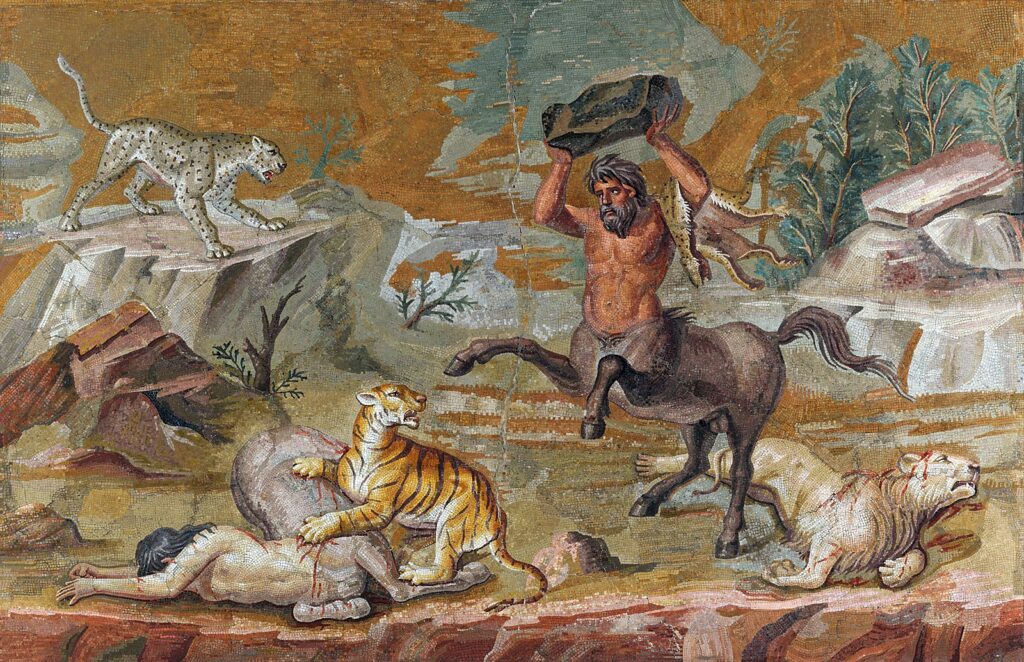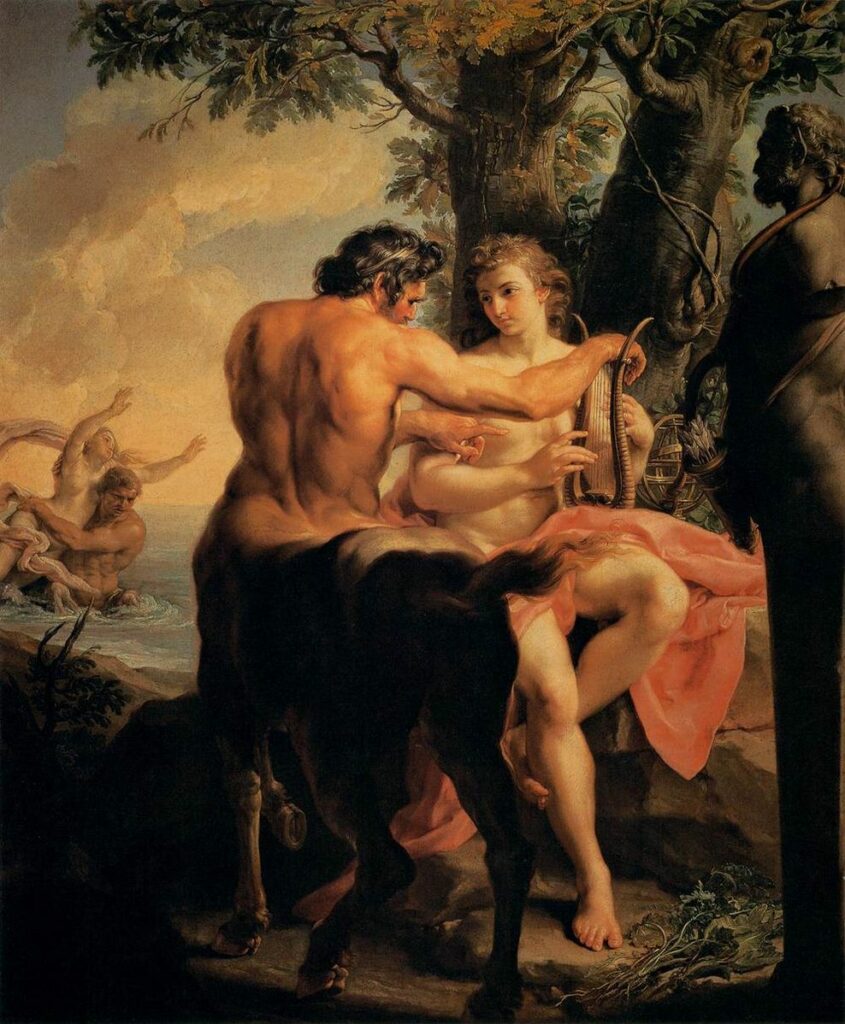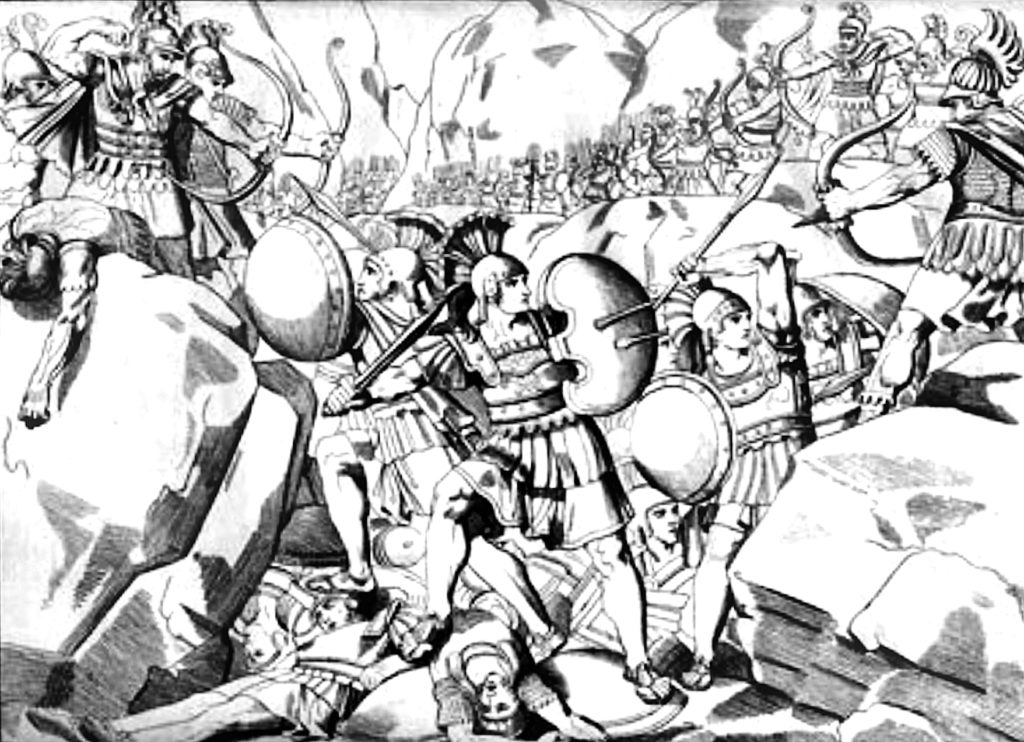The half-man, half-horse creature known as the Centaur is one of the most famous beings in Greek mythology.
It is a creature whose lower body and legs are that of a horse. And their torso and upper body are that of a human. They represented the realm between humans and nature.
Indeed, the Centaur was often stereotyped by the ancient Greeks as a creature that could not control its internal barbaric instincts.

The Origin of the Centaur
The birth of the Centaurs begins with the human king Ixion, king of the Lapiths, the oldest tribe of Thessaly. Ixion was the son of the god Ares and the princess Pirene. He was said to be an expert horseman and charioteer.
Ixion married a woman named Dia, daughter of Deioneus. The customary dowry which was owed by Ixion for the marriage went unpaid so Deioneus stole a herd of Ixion’s horses for the payment.
Ixion then took revenge for the stolen goods by murdering his father-in-law. He shoved him onto a pyre of wood and coals (essentially burning him to death). For this violent act, Ixion was banished from his society.
The only one who took pity on Ixion, the god Zeus, invited the human to Mount Olympus. It was at Mount Olympus that Ixion, again, acted poorly after meeting Zeus’ wife Hera, and pursuing her.
But Zeus was all-knowing. Before a true affair began, Zeus created a cloud in the shape of Hera to trick the human king. When Ixion made love to the cloud, what was created was Centaurus, who would go on to create the race of Centaurs.
As for Ixion, after bragging to the rest of the world that he had been with Zeus’ wife, Zeus unleashed his full wrath by tying Ixion to a flaming wheel and sending it into the world to spin for all eternity.
Greek mythology is full of horrible punishments. Many modern-day researchers argue the symbolism of the fiery wheel. Many say that the fire symbolizes the sun god Helios.
But research points to the spinning wheel symbolizing an agonizing ending – a never-ending punishment for all eternity. Many artifacts depicting the event even include snakes that were secured to the wheel, torturing Ixion forever. The moral of the story is likely: never double-cross Zeus!
The Clash Between Civilization and Barbarians
It was said that the Centaurs lived in numerous tribes around the region called Pelion in Magnesia. This was located on the coast of Central Greece. They dwelled in the surrounding mountains and forests.
Writers and poets such as Pindar and Homer included Centaurs in their works. Pidnar gave us the origin story and name ‘Centaur.’ Homer described similar creatures but did not use the term “centaurs.”
What remained the same between the stories was that these creatures were monsters. They were especially violent towards women, with many stories of rape and attacks.
It was originally believed that all Centaurs were male. This accounted for all the stories of kidnapping and raping women. But in later mythology, especially Roman, female Centaurs began to emerge.
The common theme among stories involving Centaurs was of a civilization fighting bravely while triumphantly defeating these barbarians of nature.
Legends of the Uncivilized Man-Horse
The Centauromachy is a story of one such epic battle between civilization and the half-man, half-horse creatures. In this story, the King of the Lapiths, Pirithous, was to be married to Hippodamia.
Remember, it is believed that Centaurs were descendants of the former Lapith King Ixion. Because the Centaurs were kinsfolk to these people, they were present at the wedding ceremony.
As was customary to the behavior of the Centaurs, they became drunk and decided to abduct all the women at the ceremony, including the bride. An epic battle ensued.
The Greek heroes Theseus, Peleus, and Nestor were present at the wedding and ready to defend their people from the ways of the Centaurs. Many of the Centaur race died that day and the ones who survived were said to have fled Thessaly and created new tribes in Malea and Mount Pholoe.
It was the Lapiths who especially hated the Centaurs and wanted them removed from existence as they recognized the ancestral connection between themselves and the man-beasts. Lapiths knew that the Centaurs represented the idea that they, too, could become evil, vile creatures. The Lapiths were merciless in trying to rid civilization of the Centaurs.

Another such story involved a Centaur named Nessus who worked as a ferryman. He transported travelers across the River Evenus on his back. Hercules and his wife Deianeira were one of those travelers.
When Nessus safely delivered Deianeira to the other side of the river, he decided he wanted to have his way with her and ran off into the woods with her still on his back. Holding on for dear life upon the charging Nessus, Deianeira screamed and her husband heard her cries.
Hercules took chase and shot his bow with a poisoned arrow into the heart of the Centaur. Some accounts of the story relay that as the Centaur lay dying, he plotted his revenge against the hero.
Nessus told Deianeira that if she would take a small vial of his blood, a great advantage would one day be hers. He explained that if her husband’s love for her ever seemed to fade, a potion made from his blood and poured on her husband’s clothes would revive his love for her.
Years passed. When the wife eventually felt her husband’s love fading, she did as the dying Nessus had told her to do. Upon dressing in the clothing that was soaked in Nessus’ blood, Hercules’ skin began to burn. The powerful blood, which was indeed a poison, killed the hero Hercules.
The More Civilized Centaurs
There were also two good Centaurs in Greek mythology: Pholus and Chiron.
There is a myth involving the hero Hercules and one of these Centaurs. In this story, Hercules visits the Centaur Pholus in his cave on Mount Pholoe.
Pholus was a friend to Hercules. As the hero was passing through the region, the Centaur entertained Hercules and made him a feast. Hercules was adamant about opening a jar of wine at the mouth of Pholus’ cave.
Pholus warned his friend that opening the wine would be a horrible mistake if his fellow Centaurs were to smell the sweet aroma from the jar. After Pholus relented to his friend and opened the jar of wine, neighboring Centaurs smelled the sweetness, as was foretold.
In the mad, violent frenzy the smell evoked, the Centaurs charged the cave. But Hercules was able to slay many of the charging Centaurs. The Centaurs who survived were chased from the region.
Chiron the Medicine Man
The most well-known Centaur was named Chiron. He was a friend to numerous heroes of Greek mythology.
The wisest of all the Centaurs, Chiron acted as a tutor to many Greek heroes. The opposite of his savage counterparts, Chiron was a civilized, well-educated scholar.
To explain this discrepancy between savage Centaurs and this scholar Centaur, many believed that Chiron had different parents and did not descend from the failure, Ixion. Chiron’s lineage made him a steed and therefore, immortal.
Chiron lived in a cave atop Mount Pelion in Magnesia. It was said that he studied many subjects there, including medicine and music. It was believed by many in Greek mythology that Chiron was the father of medicine and surgery.
It was said that these intellectual gifts were given to Chiron by the gods Artemis and Apollo. But it was also surmised that he gained his knowledge by learning from these gods.
Chiron married Chariclo, a nymph of Mount Pelion. Nymphs were female deities that were mainly responsible for the care of plants and animals. They were not immortal, but normally lived a long time, and were said to be very fertile.
Even though they were ranked below the gods, they were still invited to the assemblies of the gods on Olympus. The marriage between Chiron and Chariclo was said to have brought forth many sons, daughters, and an unknown number of nymphs as well. The group of nymphs born to the couple were called Pelionides.
Chiron was known as a great teacher and tutor to many gods and heroes including Perseus, Theseus, Jason, Ajax the Great, Patroclus, and his greatest pupil, Achilles. Chiron taught skills that were needed by men including medicine and understanding which plants were useful for healing, music, archery, and hunting. He explained the constellations and the legends behind them.

Although Chiron was believed to be immortal, he did eventually meet his death in a unique way.
His death ties into the previous story of Hercules and the Centaur Pholus. Chiron was involved in the great charge when the sweet wine bottle was opened in Pholus’ cave. One of Hercules’ poisoned arrows struck Chiron in the knee.
Although he was immortal, the poison still caused excruciating pain in Chiron’s body. He suffered for nine days before admitting that he would rather be dead than live with the agonizing pain forever.
Two versions surround his ultimate demise. One is that Chiron went to Zeus and asked him to remove his immortality. The other says that Hercules was the one who asked his father Zeus to remove immortality and help end his friend’s suffering.
However it was arranged, Zeus granted this request. When Chiron died, he was placed in the heavens amongst the stars as part of the constellation Centaurus.
Centaurs Outside Greek Mythology
Centaurs are one of the most recognizable characters in Greek mythology. They are still referenced an unlimited number of times in modern culture. Centaurs have been mentioned in novels, graphic novels, movies, television, and video games.
Centaurs are usually depicted as wild and uncivilized. In J.K. Rowling’s Harry Potter series, Centaurs do have some skills that are productive to society, but are mainly portrayed as barbarians.
The Centaur Firenze teaches at Hogwarts and is known for his intelligence in astronomy and healing remedies. In Rick Riordan’s Percy Jackson series, they are wild and reckless, except for the educated Chiron.
As in many cases, and in stories of Greek mythology, although Centaurs were looked at as reckless and wild, they also possessed knowledge.
Images of Centaurs have also been seen in ancient art, as well as more modern examples. Pottery and paintings from ancient Greek civilizations show well-known characters, such as Medusa, as a Centaur.
Scientists have discovered a combination of ways to depict Centaurs. There are examples of Centaurs with equine forelegs, with human forelegs, and with human forelegs but hooves instead of human feet.
There is pottery adorned with Centaurs pulling chariots, Centaurs with wings that can fly, and Centaurs as females with female bodies atop equine legs.
As Centaurs are very hard to mistake visually, examples in art, and especially sculpture, are easy to identify. Scenes portraying Centaurs were found at The Temple of Zeus in Olympia, which was created in the fifth century. They are also found, exquisitely carved, at The Parthenon.
Lasting Symbolism
The line between civilization and nature can be thin. The Centaurs represented animalistic impulses, which the Greek gods and heroes knew everyone possessed deep down.
Perhaps this is why the Centaur is still used in many modern cultural references, forever linking nature with the human race. In a place where civilized strength and intelligence meet an animalistic urge to drink, party, plunder, and take what we desire, we have the Centaur.

